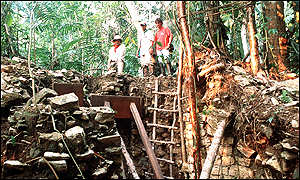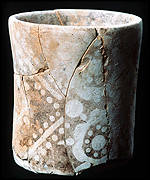 |
![]()

text translation service for 25 worldwide languages
This
archive is about the various discoveries in 2000 which have helped to
create the ‘paradigm shift’
in the historical sciences that characterises the ‘new
appreciation’ of the ancient world.
The
Morien Institute welcomes contributions
from everywhere in the world. Wherever you are, if your traditional prehistory
has been challenged by new discoveries, please
send us the press reports
webpage URLs and magazine stories …
1997 |
1998 |
1999 |
2001 |
“Clue to Romans’ head start on Columbus”
This was the
headline of an article in The
Guardian newspaper for February 10 2000,
writen by James Meek. It told of a tiny black terracotta head which had
been locked away in a Mexican museum for many years.
If this
artifact was indeed lost in the place where it was originally discovered,
it could prove that the Romans reached the new world some 1,200 years
‘before’ Christopher Columbus,
and that would put a lot of precious paradigms on a very wobbly footing.
“The sculpted head of a bearded man, dug up in the Toluca valley, 65
miles west of Mexico City in 1933, has been identified as Roman by art
experts and dated to the third century AD by a sophisticated new dating
technique.”
But nothing
is as simple as it first appears, and when it was originally unearthed,
the artifact, which is only a few centimetres high, was found in a burial
chamber under three floors, which arch?ologists concluded could not have
been sealed earlier than 1510, a decade before the first known European
landings in Central America.
The story
first broke in the New Scientist, and James Meek’s report of that tells
that according to Roman Hristov, a US anthropologist, this is the first
real proof of human contacts across the Atlantic before the arrival of
Columbus in 1492. Meek reported that:
“This week’s New Scientist reports that Hristov and a Mexican colleague,
Santiago Genov?s, had read about the head and finally tracked it down,
locked in the vaults of a museum in the Mexican capital.
The head looks unlike the artwork produced by the native peoples of the
region before Columbus.
But the notion that it proves Roman contacts with pre-Columbian America
will face stiff resistance from hordes of academics in a bitterly contested
field.”
In the
past, scientists have suggested that the Vikings, Celts and Africans may
have crossed the Atlantic before Columbus, Meek told Guardian readers,
and also that remains of a settlement in Newfoundland have been identified
as the gateway to the Vikings’ fabled Vinland.
As ever in these cases it seems, the New Scientist reportedly left the last word with a sceptic:
David Grove, an archaeologist at the University of Illinois at Urbana-Champaign,
told the New Scientist that the head was Roman, but pointed out it could
have been washed ashore from a Roman shipwreck in the Gulf of Mexico –
not exactly a Roman “discovery” of the New
World.
Doesn’t it make
you wonder just how many similar artifacts are still locked away in the
vaults of museums and university arch?ology departments around the world?.
underwater discoveries news archive
“Is the Virgin Mary buried on
Anglesey?”
This amazing
headline appeared in the North Wales Daily Post
on Thursday, March 16 2000, and, alongside
a picture of St. Mary’s Church in Llanerchymedd, and a bemused-looking
vicar’s warden, it told the story of an author, Graham Phillips, whose
controvesial theory has recently been slammed as “ridiculous”
and “far-fetched”. The claims
are made in his recently published book,
“The Marian Conspiracy”, in which Graham Phillips puts
forward the idea that after the crucifixion Joseph was persecuted, and
fled with Mary to Wales.
He claims
she died in Wales and was buried in Anglesey, probably on the site at
Llanerchymedd where the St. Mary’s Church was later built. But a retired
Church in Wales priest, Edgar Jones, told the North Wales Daily
Post he had never heard of such a story:
“I have written books and various articles on the history of Angelsey,
particularly its churches, and this is a ridiculous claim, just too silly
for words, … Anyway the church dates back to Norman times when many
were called either Mary or Michael.”
Graham
Phillips has studied documentary evidence from the 5th and 6th centuries
AD, which he claims show that Joseph did indeed flee persecution after
the crucifixtion, and he also claims that he has researched a letter from
St. Augustine, the first Archbishop of Canterbury, who wrote to the then
Pope in AD 597, claiming to have found Mary’s tomb in a church on an island
off the west coast of Britain.
Graham Phillips
admits that his claims may not go down too well with the Catholic Church:
“I believe the Vatican tried to suppress the story of this tomb in
the Middle Ages and since 1950 the Pope made it official that the Virgin
Mary ascended bodily into heaven.”
underwater discoveries news archive
“Mayan palace found buried in jungle”
It was
reported in The Times newspaper on
September 9 2000 that arch?ologists
working in the Guatemalan jungle have uncovered the ruins of an 8th century
Mayan palace known as ‘Cancu?n’,
or “the Place of Serpents”,
which experts are calling one of the largest an dmost splendid structures
of its kind ever to be discovered.
Independent on the same day also carried the story, and further
reported that the palace was made of limestone and is full of jade and
mirrors. “What is most incredible about this
site is that most of the palace is buried virtually intact,”,
Arthur Demarest, a Tennessee scientist overseeing the historic dig sponsored
by Vanderbilt University, the National Geographic Society and the Guatemalan
Institute of Anthropology and History, told the Independent:
“The new discovery, which once overlooked the Passion River, dates
from AD740 and is expected to rival any of the royal residences at Tikal,
considered the pinnacle of classic Mayan city-states.”
The BBC
had flagged the story the previous day, but also ran a longer piece on
the BBC
News Online website on September 9 2000,
which reported that arch?ologists had known about Can Cuen for around
100 years, but it was recently discovered references to Can Cuen’s importance
as a trading centre that had forced researchers to look more closely at
the site.
|
BBC Online |
The BBC also interviewed Dr Demarest. One day he was walking along the palace’s highest level when he fell up to his armpits in vegetation that had filled a hidden courtyard. He told the BBC:
“That’s when I realised the entire hill was a three storey building, and we were walking along the top of the roof,” They had been at the site for about two weeks without realising the extent even of the main palace buried in the jungle. An amazing find! |
The
Times commented that the discovery will help to shed light
on the Mayan civilisation of Central America, and said that scholarly
thinking had traditionally held it to have been a predominently warfaring
society. But that at ‘Cancu?n’
arch?ologists had have found evidence of unexpectedly rich craftsmanship,
suggesting that the Mayans were also capable of more sophisticated pursuits.
This new
site is said to rival ‘Tikal’,
80 miles to the north, which had previously been regarded as the greatest
discovery of the Mayan presence in Guatemala to date. But, Dr Demerest
told The Times that:
“No one had found anything like this since the turn of the last century.
What is most incredible about this site is that most of the palace is
buried virtually intact.”
This was the
second major archaeological find in this region this year. Earlier, a
different team of arch?ologists unearthed the ruins of a city known as
‘El Pajaral’, which seems to
have been an important pilgrimage destination for the whole of the ancient
Mayan world, The Times reported.
|
BBC Online |
The BBC also interviewed one of Guatemala’s foremost authorities on deciphering Mayan hieroglyphics, Frederico Fahsen, whotold them that most Mayan kingdoms relied on religion and warfare for their power but it seems that Can Cuen kings thrived for more than 1,000 years on commerce alone using their wealth to forge alliances with neighbours. He told the BBC:
“Mayan cities were in a constant state of war with their structures dedicated to the Gods in heaven. Now we’ve discovered something exactly the opposite,” |
The image
above is of a Mayan artifact discovered by the arch?ologists at Cancuen,
who say it will take them at least 10 years to excavate the entire city,
which covers 13 sq km. It’s discovery has already forced scholars to review
their ideas about the ancient Mayan mines. Arch?ologists have reported
finding jade and pyrites (better known as
Fools Gold) littered all around the site, including, in
one palace workshop, a massive 35lb chunk of jade.
This was
very rich city, which appears to have survived for hundreds of years without
the warfare that has previously been thought to have covered the whole
of the Mayan areas. Also absent from Cancuen are any signs of the traditional
religious displays that were used as symbols of power by the Mayan kings.
So there
we have it again. It seems that yet another whole ‘accepted’
history has to be reviewed in the light of a new discovery …
please visit our
underwater discoveries news archive
before you leave
please take a look at our Ancient Mysteries Bookshoppe for a wide selection of books
that challenge orthodox views of prehistory on every continent
home |
us
expeditions, conferences, workshops & study-tours
all material on this page
morien institute
morien-institute.org1996-2005

